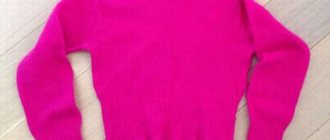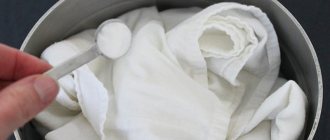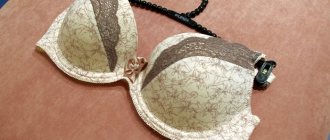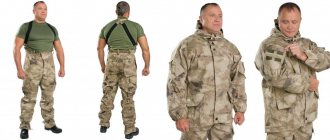What is acrylic and what properties does this material have?
Acrylic is a synthetic material. It is considered a wool substitute because it has high thermal insulation properties and warms, but is much cheaper than products made from natural material. Acrylic fabrics have some features that distinguish them from other fabrics:
- soft and pleasant to the touch;
- does not absorb moisture well;
- almost does not wrinkle or deform;
- dries quickly after getting wet;
- easily absorbs fat;
- not susceptible to attacks by moths and other pests;
- does not provoke allergies;
- The products have a durable color, but if not properly cared for, the colors quickly fade.
Among the significant disadvantages of the material is the tendency to stretch and form pellets during wear. However, if you follow the rules of care for an acrylic item, you can significantly extend its life.
How to properly wash an acrylic item in a washing machine?
Acrylic sweaters and other items made from artificial wool substitute can most often be washed in a machine; usually the possibility of this method of cleaning from dirt is indicated on the manufacturer's tag. It is worth remembering that acrylic fabric is synthetic and does not withstand high temperatures. Hot water causes the material to lose its softness, become rough and stretch or shrink.
To avoid deformation of the item, it is recommended to place it in a special bag. Heavily soiled items should be soaked in soapy water before loading into the drum. If there are stains, they must also be removed in advance. Basic recommendations for machine washing acrylic items:
- Do not load too many products into the drum, as this may lead to the formation of creases in the acrylic;
- You can add universal washing powder to the compartment, but it is better to use a gel detergent;
- It is recommended to select a delicate mode or set the regulator to the “wool”, “synthetic” or “hand wash” mode;
- the water temperature should be no higher than 30–40°C;
- It is advisable to add a cap of emollient to the conditioner compartment (it adds aroma, softness, and reduces the likelihood of pilling).
Often, hats, sweaters and other items are not made from 100 percent synthetics, but with the addition of cotton or wool. Manufacturers recommend that such clothes be washed by hand or dry cleaned. However, if the composition contains 50–70% artificial fibers, the product can be safely placed in the drum of the washing machine. Bleach should only be used on white items and only if it does not contain chlorine.
How to wash acrylic by hand
Hand washing of acrylic items is recommended in cases where the clothing has all kinds of decorations that cannot be removed temporarily (beads, brooches, rhinestones, etc.). It is recommended to use regular laundry soap to remove dirt, rather than expensive specialized powder. You might be interested in learning how to care for fleece fabric.
You can wash this synthetic fabric by hand at a water temperature of 30-35 degrees (better lower than higher). This is due to the fact that when heated, the artificial material begins to quickly lose its softness and loses its original shape, which it will never return. Therefore, when talking about whether acrylic shrinks after washing, it can be noted that this happens in cases where the fabric is washed at high temperatures.
The entire list of synthetic fabrics is here.
To prevent the formation of pilling on clothes (they appear especially often on acrylic sweaters), it is recommended to wash with a softener, as well as an antistatic agent, which will prevent clothes from sticking to the body.
Finally, you need to wrap the washed clothes in a towel and gently wring them out without twisting the material.
Recommendations for hand washing acrylic products
If the hat, cardigan or other clothing has a large knit or is decorated with beads, sequins or other elements, it is better to choose hand washing. For large knit sweaters, this cleaning method minimizes the risk of fabric deformation. To maintain the appearance of the product, you must follow the recommendations:
- Fill a basin with cool water and dissolve the detergent in it;
- soak the clothes for 5 minutes, wash the neckline and cuffs (light laundry soap is good for removing stains);
- leave the product to soak for another 10–15 minutes;
- wash and rinse the item twice in cold water.
Clothes should not be rubbed too hard - excessive force will lead to damage to the fabric, deformation and the appearance of pills. When rinsing, it is recommended to add a little conditioner or antistatic agent to the water. You can prepare the latter yourself using regular hair balm, a little salt and table vinegar. It will soften the product and prevent the accumulation of static electricity during subsequent wear.
Is it possible to wring out acrylic items and how to dry them?
If you decide to wash the item in a machine, you can spin it at low speed (no more than 500 per minute). When removing the product from the drum, it should remain slightly damp.
When washing by hand, it is strictly forbidden to strongly squeeze or twist clothes made from synthetic threads due to possible deformation of the fibers. The product can be lightly wrung out, and then wrapped in a towel and pressed - the bamboo or cotton cloth will instantly absorb excess water. You can use several towels, changing them as they get wet.
In order for an acrylic sweater to retain its appearance after washing, it must be dried properly. Under no circumstances should you hang the product on a battery, as marks may remain on the item and it will shrink. It is also prohibited to hang products on a clothesline or hanger, as they may stretch excessively.
After a high-quality and careful spin, the item should be slightly shaken to straighten out creases and laid out horizontally to dry on a terry towel or cotton fabric. It needs to be shaped by aligning the seams and bottom line, stretching out the neckline. The product should remain in this form until completely dry. If the backing becomes very wet, it will need to be changed and the clothing carefully straightened out again.
Acrylic products cannot be ironed with a hot iron or steamed. However, if the fabric contains admixtures of cotton or other natural raw materials, ironing at a low temperature through damp gauze is acceptable.
How to wash acrylic in a washing machine
Many housewives do not know in what mode and at what temperature to wash acrylic, so they simply choose a delicate program. This is the right decision, because washing this synthetic fabric in a washing machine is allowed only at a temperature of no more than 30 degrees. In addition, it is strongly recommended to set the minimum possible spin speed - 300-500 (if possible).
If possible, you should wash acrylic items in a special bag, which are widely available in stores today. You can choose regular washing powder, since there is no point in washing knitted acrylic items with expensive specialized detergents. If you can set the “Wool” mode on your washing machine, then in the case of acrylic items this will be the best option.
Many housewives do not know how to clean acrylic, so they use standard bleaches. This is the wrong approach, because if you wash with bleach, this can negatively affect the quality of the material and lead to problems in its further use.
Also, do not wash with the drying and ironing programs provided in modern washing machines. Their use can also cause damage to this synthetic material. At the end of washing, the acrylic item should be wet or damp, not dry. Following simple rules on how to wash acrylic in a machine will extend the life of your clothing several times.
Why did a sweater or hat shrink after washing and how to fix it?
To prevent acrylic clothing from shrinking, it should not be washed in hot water. Low temperature allows you to preserve not only the appearance of the product, but also the properties of the fabric. However, if the thing does shrink, this is not a reason to be upset. A hat, sweater or favorite acrylic cardigan can be returned to its original size.
To correct the situation that arose after improper washing and drying, soaking in cool water with the addition of regular fabric softener will help. The item should be placed in water for 10–15 minutes, then lightly squeezed, wrapped in a towel and squeezed again. After the procedure, the clothes must be straightened on a horizontal surface and stretched to the sides, applying equal forces in all areas. The product should be left to dry, repeating stretching every half hour.
Experienced housewives recommend pulling a shrunken hat onto a jar. If you have free time, you can put on your favorite sweater, which has shrunk in width, and walk around in it until it dries completely.
There is a more extreme way to stretch an acrylic item. It can be soaked for a day in water, to which you need to add grated laundry soap, a tablespoon of turpentine and three tablespoons of ammonia. After the procedure, the clothes are stretched and dried on a flat surface, placing a towel to absorb moisture. Manipulation is not suitable for products made from natural wool. If the size changes unevenly and the clothing is severely deformed, it will not be possible to return it to its original shape.
Washing in a washing machine
Items that do not have any special instructions on their labels are suitable for machine washing. Colored underwear is selected by color, white separately.
- Acrylic sweater: pros and cons, current styles and models, rules for caring for the product
ARTICLE FOR YOU How to properly wash cotton linen and clothes: in a washing machine and by hand
Preparing things:
- fasten all fasteners;
- check pockets and folds for debris and other items;
- turn inside out;
- remove all difficult stains in advance.
Before loading into the machine, acrylic items are soaked for 10 minutes in soapy water. The drum should not be heavily loaded. Things take up less than half the space. Synthetic fabrics need a lot of space to perform well. If possible, turn off the spin and dry functions.
To prevent things from becoming deformed or stretched after washing, use the mode for thin fabrics (synthetics, silk or wool), the temperature is not higher than 30 degrees. In this case, the washing machine will use a gentle spin and low speed without damaging the fabric structure. To prevent stretching, special mesh bags are used. They do not allow things to stretch while the centrifuge is running.
Fabric softener
How to wash without shrinking fabric
To prevent clothes made from acrylic fiber from shrinking, you need to maintain temperature conditions. If the water temperature is above 40 degrees, then there is a high probability of deformation of the fabric.
If the item could not be saved and it has shrunk, then you can try to return it to its original form. Examine it. In the case when the change in size does not occur evenly and the clothing looks like a disproportionate flap, nothing can be done. It can be thrown away or used for other purposes.
When the size has become smaller, but the clothing has retained its appearance, you can return to the original parameters. To do this, soak the clothes in cool water with synthetic conditioner added for 10-15 minutes.
Wring out the water by wrapping the clothes in a towel. Do not twist, just squeeze and let the water drain. Place on a horizontal surface and stretch, securing in the desired position. In this form, the clothes should dry. A shrunken hat can be pulled over a jar or other suitable object.
ARTICLE FOR YOU How to wash linen and flannel items: in a washing machine and by hand
If the conditioner procedure does not help, there is a more extreme option. Add turpentine and ammonia in small quantities to the water for soaking (no more than a tablespoon of turpentine, and no more than 3 alcohol for soaking one item). Attention! This method is not suitable for natural wool!
If the sweater or T-shirt has decreased in width, put the wet item on yourself and let it dry.
- Caring for viscose: how to properly wash, dry and iron viscose items
The sweater shrank after washing
How to wash things to sit down
If clothes have stretched as a result of careless wear or strong spinning in a washing machine, then their appearance can be restored in the following way.
When this happened as a result of an incorrect spin mode, the stretching is usually uniform and along the entire length of the product. You can return it to its original size by washing the item in compliance with all the rules and using conditioner.
Stretched sleeves on a sweater or turtleneck appear due to constant pulling and tugging. To correct this defect, immerse only the problematic parts in water at a temperature of 50 degrees. Dry on a horizontal surface. It is not recommended to use too high a temperature as this will destroy the nitrone.











